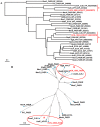Multidrug Efflux Systems in Helicobacter cinaedi
- PMID: 27029418
- PMCID: PMC4790245
- DOI: 10.3390/antibiotics1010029
Multidrug Efflux Systems in Helicobacter cinaedi
Abstract
Helicobacter cinaedi causes infections, such as bacteremia, diarrhea and cellulitis in mainly immunocompromised patients. This pathogen is often problematic to analyze, and insufficient information is available, because it grows slowly and poorly in subculture under a microaerobic atmosphere. The first-choice therapy to eradicate H. cinaedi is antimicrobial chemotherapy; however, its use is linked to the development of resistance. Although we need to understand the antimicrobial resistance mechanisms of H. cinaedi, unfortunately, sufficient genetic tools for H. cinaedi have not yet been developed. In July 2012, the complete sequence of H. cinaedi strain PAGU 611, isolated from a case of human bacteremia, was announced. This strain possesses multidrug efflux systems, intrinsic antimicrobial resistance mechanisms and typical mutations in gyrA and the 23S rRNA gene, which are involved in acquired resistance to fluoroquinolones and macrolides, respectively. Here, we compare the organization and properties of the efflux systems of H. cinaedi with the multidrug efflux systems identified in other bacteria.
Keywords: Helicobacter cinaedi; antimicrobial resistance; efflux.
Figures



Similar articles
-
[Three Cases of Bacteremia due to Helicobacter cinaedi Infection and the Usefulness of Gene Analysis of Isolated Bacteria].J UOEH. 2015 Dec 1;37(4):293-8. doi: 10.7888/juoeh.37.293. J UOEH. 2015. PMID: 26667196 Japanese.
-
Helicobacter cinaedi bacteremia resulting from antimicrobial resistance acquired during treatment for X-linked agammaglobulinemia.J Infect Chemother. 2016 Oct;22(10):704-6. doi: 10.1016/j.jiac.2016.02.008. Epub 2016 Mar 31. J Infect Chemother. 2016. PMID: 27040158
-
First case report of thyroid abscess caused by Helicobacter cinaedi presenting with thyroid storm.BMC Infect Dis. 2019 Feb 15;19(1):166. doi: 10.1186/s12879-019-3808-7. BMC Infect Dis. 2019. PMID: 30770725 Free PMC article.
-
First case of bacteremia caused by Helicobacter cinaedi in a patient with liver cirrhosis: a case report and literature review.Clin J Gastroenterol. 2015 Oct;8(5):306-17. doi: 10.1007/s12328-015-0600-0. Epub 2015 Sep 5. Clin J Gastroenterol. 2015. PMID: 26342291 Review.
-
Multifocal cellulitis and monoarticular arthritis as manifestations of Helicobacter cinaedi bacteremia.Clin Infect Dis. 1995 Mar;20(3):564-70. doi: 10.1093/clinids/20.3.564. Clin Infect Dis. 1995. PMID: 7756476 Review.
Cited by
-
The challenge of efflux-mediated antibiotic resistance in Gram-negative bacteria.Clin Microbiol Rev. 2015 Apr;28(2):337-418. doi: 10.1128/CMR.00117-14. Clin Microbiol Rev. 2015. PMID: 25788514 Free PMC article. Review.
-
Mutations in Genes Encoding Penicillin-Binding Proteins and Efflux Pumps Play a Role in β-Lactam Resistance in Helicobacter cinaedi.Antimicrob Agents Chemother. 2018 Jan 25;62(2):e02036-17. doi: 10.1128/AAC.02036-17. Print 2018 Feb. Antimicrob Agents Chemother. 2018. PMID: 29203490 Free PMC article.
References
-
- Lawson A.J. Helicobacter . In: Versalovic J., Carroll K.C., Funke G., Jorgensen J.H., Landry M.L., Warnock D.W., editors. Manual of Clinical Microbiology. 10th. Volume 1. ASM Press; Washington D.C., USA: 2011. pp. 900–915.
-
- Khan S., Okamoto T., Enomoto K., Sakashita N., Oyama K., Fujii S., Sawa T., Takeya M., Ogawa H., Yamabe H., et al. Potential Association of Helicobacter cinaedi with Atrial Arrhythmias and Atherosclerosis. Microbiol. Immunol. 2012;56:145–154. - PubMed
-
- Tomida J., Kashida M., Oinishi K., Endo R., Morita Y., Kawamura Y. Evaluation of Various Media for Rapid Detection of Helicobacter spp. J. Jpn. Soc. Clin. Microbiol. 2008;18:227–235.
Publication types
LinkOut - more resources
Full Text Sources
Molecular Biology Databases

